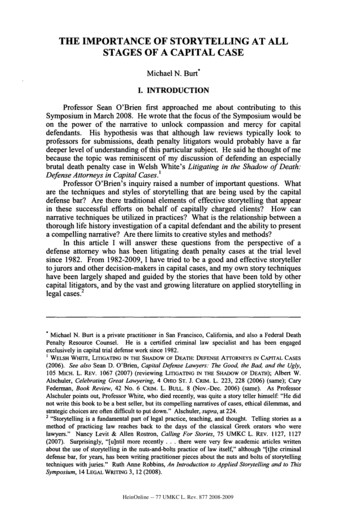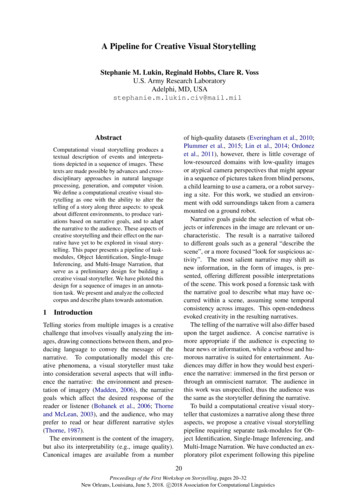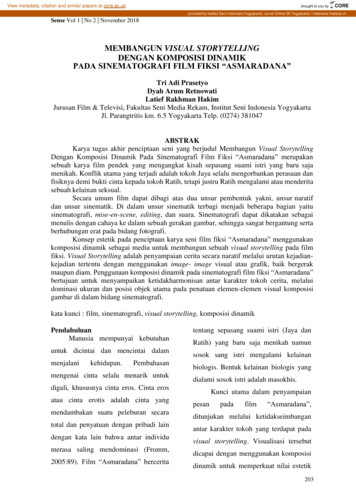
Transcription
THE IMPORTANCE OF STORYTELLING AT ALLSTAGES OF A CAPITAL CASEMichael N. Burt*I. INTRODUCTIONProfessor Sean O'Brien first approached me about contributing to thisSymposium in March 2008. He wrote that the focus of the Symposium would beon the power of the narrative to unlock compassion and mercy for capitaldefendants. His hypothesis was that although law reviews typically look toprofessors for submissions, death penalty litigators would probably have a fardeeper level of understanding of this particular subject. He said he thought of mebecause the topic was reminiscent of my discussion of defending an especiallybrutal death penalty case in Welsh White's Litigating in the Shadow of Death:Defense Attorneys in Capital Cases.'Professor O'Brien's inquiry raised a number of important questions. Whatare the techniques and styles of storytelling that are being used by the capitaldefense bar? Are there traditional elements of effective storytelling that appearin these successful efforts on behalf of capitally charged clients? How cannarrative techniques be utilized in practices? What is the relationship between athorough life history investigation of a capital defendant and the ability to presenta compelling narrative? Are there limits to creative styles and methods?In this article I will answer these questions from the perspective of adefense attorney who has been litigating death penalty cases at the trial levelsince 1982. From 1982-2009, I have tried to be a good and effective storytellerto jurors and other decision-makers in capital cases, and my own story techniqueshave been largely shaped and guided by the stories that have been told by othercapital litigators, and by the vast and growing literature on applied storytelling inlegal cases. 2* Michael N. Burt is a private practitioner in San Francisco, California, and also a Federal DeathPenalty Resource Counsel. He is a certified criminal law specialist and has been engagedexclusively in capital trial defense work since 1982.1 WELSH WHITE, LITIGATING IN THE SHADOW OF DEATH: DEFENSE ATTORNEYS 1N CAPITAL CASES(2006). See also Sean D. O'Brien, CapitalDefense Lawyers: The Good, the Bad, and the Ugly,105 MICH. L. REv. 1067 (2007) (reviewing LITIGATING IN THE SHADOW OF DEATH); Albert W.Alschuler, Celebrating Great Lawyering, 4 OHIo ST. J. CRIM. L. 223, 228 (2006) (same); CaryFederman, Book Review, 42 No. 6 CRIM. L. BULL. 8 (Nov.-Dec. 2006) (same). As ProfessorAlschuler points out, Professor White, who died recently, was quite a story teller himself: "He didnot write this book to be a best seller, but its compelling narratives of cases, ethical dilemmas, andstrategic choices are often difficult to put down." Alschuler, supra,at 224.2 "Storytelling is a fundamental part of legal practice, teaching, and thought. Telling stories as amethod of practicing law reaches back to the days of the classical Greek orators who werelawyers." Nancy Levit & Allen Rostron, Calling For Stories, 75 UMKC L. REv. 1127, 1127(2007). Surprisingly, "[u]ntil more recently . there were very few academic articles writtenabout the use of storytelling in the nuts-and-bolts practice of law itself," although "[t]he criminaldefense bar, for years, has been writing practitioner pieces about the nuts and bolts of storytellingtechniques with juries." Ruth Anne Robbins, An Introduction to Applied Storytelling and to ThisSymposium, 14 LEGAL WRITING 3, 12 (2008).HeinOnline -- 77 UMKC L. Rev. 877 2008-2009
UMKC LA W REVIEW[Vol. 77:4One of the best academic works written on the use of storytelling in trial work is SamSchrager's 1999 book, The Trial Lawyer's Art, which is based on the author's work as curator ofthe American Trial Lawyers program at the Smithsonian Institute's Festival of American Folklore.See also W. LANCE BENNETT & MARTHA S. FELDMAN, RECONSTRUCTING REALITY IN THECOURTROOM: JUSTICE AND JUDGMENT IN AMERICAN CULTURE 3 (1981) ("Our search for theunderlying basis of justice and judgment in American criminal trials has produced an interestingconclusion: the criminal trial is organized around storytelling."); Philip N. Meyer, "DesperateforLove": Cinematic Influences Upon a Defendant's Closing Argument to a Jury, 18 VT. L. REV. 721(1994) (detailing closing argument by attorney Jeremiah Donovan in trial of United States v.Bianco, No. H-90-18 (D. Conn. July 16, 1991), and showing how it is more like a movie than a"textbook" closing argument) [hereinafter Meyer, Cinematic]; Jeremiah Donovan, Some Off-theCuff Remarks About Lawyers as Storytellers, 18 VT. L. REV. 751 (1994) (transcript of Donovan'sresponse to Meyer's piece, given at "Lawyers as Storytellers & Storytellers as Lawyers: AnInterdisciplinary Symposium Exploring the Use of Storytelling in the Practice of Law," in whichDonovan expresses how he structures closings, and that he does not consciously follow a moviestructure).Many of the academic articles focus on storytelling in brief writing or in appellate oralarguments or judicial opinions. See Anthony G. Amsterdam, Telling Stories and Stories AboutThem, 1 CLINICAL. L. REV. 9 (1994) (analyzing oral arguments made in front of the Supreme Courtto support a position that legal arguments tell a story by using narrative techniques); Kenneth D.Chestek, The Plot Thickens: The Appellate Brief as Story, 14 LEGAL WRITING 127 (2008)(considering a story arc model for brief writing); Brian J. Foley & Ruth Anne Robbins, Fiction101:.A Primerfor Lawyers on How to Use Fiction Writing Techniques to Write Persuasive FactsSections, 32 RUTGERS L.J. 459 (Winter 2001); Gary S. Gildin, Reality ProgrammingLessons forTwenty-First Century Trial Lawyering, 31 STETSON L. REV. 61 (2001) (using storytelling to appealto Generation X); Philip N. Meyer, Are the Characters in a Death Penalty Brief Like theCharactersin a Movie?, 32 VT. L. REV. 877, 877-78 (2008) [hereinafter Meyer, Characters];ElysePepper, The Casefor "Thinking Like a Filmmaker": Using Lars von Trier's Dogville as a Modelfor Writing a Statement of Facts, 14 LEGAL WRITING 171 (2008) (suggesting that students can learnstorytelling techniques from pop culture by recognizing that film makers are also advocates foroutcomes based on narrative clues told throughout the movie). See generally ANTHONY G.AMSTERDAM & JEROME BRUNER, MINDING THE LAW (2000) (looking at, among other issues, theUnited States Supreme Court's use of storytelling as part of the decision-making process).Probably the best practitioner piece about the nuts and bolts of storytelling techniques withjuries is GERRY SPENCE, WIN YOUR CASE: How TO PRESENT, PERSUADE, AND PREVAIL EVERYPLACE, EVERY TIME (2005). Spence's storytelling abilities are legendary, and he sponsors a TrialLawyer's College in which he teaches storytelling and psychodramic techniques to trial lawyers.See About the Trial Lawyers College, http://triallawyerscollege.com/tlc/abouttlc.html.A veryuseful Web site entitled Gerry Spence & The Art of Advocacy is maintained by Professor James ehttp://myweb.wvnet.edu/-jelkins/advocacy-08 (last visited Mar. 17, 2009). The "Storytelling"section of the Web site has many links to trial practitioner articles on the subject. For informationand resources on storytelling in general, see InternationalStorytelling Center,http://www.storytellingfoundation.net (last visited Mar. 17, 2009). Several books by trial lawyerand teacher Michael Tigar are also excellent resources on storytelling technique in trial practice.See MICHAEL TIGAR & JANE B. TIGAR, MASTERING THE CRAFT OF TRIAL ADVOCACY (2006 ed., Prof.Educ. Group 2006); MICHAEL TIGAR, ExAMINING WITNESSES (2d ed., Am. B. Assn. 2003);MICHAEL TIGAR, PERSUASION: THE LITIGATOR'S ART (Am. B. Assn. 1999). See also Deja Vishny,The Storytelling Method of Direct, WISCONSIN DEFENDER, Fall 2005, at 25, available 2005/Fall05.asp;Statements: The Art of Storytelling, 31 STETSON L. REV. 89 (2001).HeinOnline -- 77 UMKC L. Rev. 878 2008-2009Gerald R. Powell, Opening
2009]THE IMPORTANCE OF STORYTELLINGBy concentrating on defense counsel, I do not ignore or underestimate thecrimes committed or the role of the prosecutor as an effective storyteller in thesecases. As Professor Federman and many others have pointed out, "[t]he crimes(alleged or actual) are embedded in the capital punishment process; stories ofviolence form the core of criminal law and only gain strength on appeal. 3 Oneimportant limit to defense creative styles and methods in these cases is surely that"the state bats first, creating an instant narrative when someone is accused ofmurder. Words get thrown about and stick: brutal, vicious, violent, dangerous.A picture of the criminal is set in motion that carries through to the appealprocess. ' 4 From defense counsel's standpoint, the virtue of effective storytellingis "to turn the dominant narrative - the one created by the state that stresses thecrime and its brutality - upside down by calling for a reversal of traditionalcourtroom storytelling.",5 "If there is one dominant theme that explains [asuccessful defense], it is that the capital defendant's attorney must tell a powerfuland coherent story of injustice in order to obtain. . [victory]." 6At the trial level, the injustice of executing the client centers on the conceptof developing and presenting mitigation. As Professor Craig Haney has written,in a well-tried capital case, there is astark juxtaposition that now regularly occurs in capital penalty trials: aconventional "crime master narrative" - one that many jurors come into thecourtroom already endorsing or predisposed to believe - is contrasted with a"mitigation counter-narrative" that incorporates a more comprehensive andempirically well-documented understanding of a capital defendant's life.7In the pages that follow, I explore how this "mitigation counter-narrative" isactually developed and presented by skilled capital defense teams. For the mostpart, I use examples that come from my own cases or from the cases of capitaldefense practitioners or mitigation specialists that I highly respect and withwhom I have worked. My own storytelling technique in this article ischronological. 8 I begin at the beginning with the investigation of a capital case3 Federman, supra note 1, at 8. See also Craig Haney, Evolving Standardsof Decency: Advancingthe Nature and Logic of Capital Mitigation, 36 HOFSTRA L. REv. 835, 842 (2008) ("In a capitalcase, the crime master narrative is also typically at the heart of the prosecutor's argument that thejurors should return a death verdict - a heinous crime has been committed by an essentially bad orevil person who should pay the ultimate penalty. Because his crime is regarded as entirely theproduct of his free and autonomous choice-making, unencumbered by past history or presentcircumstances, the defendant alone is seen as fully culpable for it.")4 Federman, supra note 1, at 8.5 Id.6 WmrTE, supra note 1, at 178.7 Haney, supra note 3, at 836.8 "The common way of organizing a story is, as Aristotle wrote almost 2,500 years ago, in threeparts: the beginning, the middle, and the end." Foley & Robbins, supra note 2, at 475-76 (quotingARISTOTLE'S POETICS 65 (Francis Fergusson ed., S.H. Butcher trans., Hill & Wang 1961)).HeinOnline -- 77 UMKC L. Rev. 879 2008-2009
UMKC LA W REVIEW[Vol. 77:4and examine several steps in the capital criminal trial process at which effectivestorytelling is critical. 9I. THE RELATIONSHIP BETWEEN A THOROUGH LIFE HISTORYINVESTIGATION OF A CAPITAL DEFENDANT AND THE ABILITYTO PRESENT A COMPELLING NARRATIVENo matter how skillful a storyteller defense counsel might be, storytellingin death penalty cases is not like writing a novel or a screenplay, although thereare certainly common elements to all three endeavors.' 0 Most obviously, defenseattorneys cannot "engage in fiction or .invent a character out of whole cloth tosuppress the 'real' image of their client, already convicted of a heinous crime.""While there is a strong parallel between lawsuit storytelling and storytellingas entertainment, the parallel is not exact. Like any analogy, it can be takentoo far. Therefore, a word of caution is appropriate. If the jury ever comes tobelieve that a lawyer is trying to tell a good yam, then the effort is a totalfailure. The lawyer loses credibility, and the client loses the case. Thismethodology should not be taken too far and demands some subtlety. Thus,exaggeration, melodrama, or the use of props, dialogue, or other such overtlytheatrical devices can doom the storyteller to failure. As with anything donein the courtroom, sincerity is the watchword.12Therefore, an important caveat to the use of storytelling in a capital trial isthat9A trial is a retelling of the story of the occurrence. The tale is repeated in variousways by different people during the trial. The lawyer is a storyteller during voir direexamination in some jurisdictions, in opening statement, and in final argument. Also,while witnesses tell the story during direct examination, the lawyer once againbecomes the storyteller during cross-examination.Powell, supra note 2, at 90. I would argue that storytelling is critical at all stages of a capital case,including the investigative stage, negotiations, motions practice, voir dire, opening statement, directexamination, cross examination, jury instructions, and closing argument. To keep this article to asomewhat reasonable length, I will focus on the investigative stage, negotiations, voir dire, penaltyphase opening statement, penalty phase jury instructions, and penalty phase closing argument. Tipsfor storytelling at the other stages of a capital trial can be gleaned from the many resources cited infootnote 2.1oSee Wendy Nicole Duong, Law Is Law and Art Is Art and Shall the Two Ever Meet? Law andLiterature: The Comparative Creative Processes, 15 S. CAL. INTERDIsc. L.J. 1, 2 (2005) ("Asdisciplines, law and the literary art share commonalities. For example, both disciplines depend andthrive on the artful use of language. Both disciplines can, and have, become effective tools foradvocacy and social reform. Law can benefit from the craft of the literary art, and can borrowtherefrom. Conversely, the drama of the law practice and notions of jurisprudence can, and have,become a rich source of material for the literary artist to explore human nature and society.")11Federman, supra note 1, at 8; see also Powell, supra note 2, at 90.12 Powell, supra note 2, at 91.HeinOnline -- 77 UMKC L. Rev. 880 2008-2009
2009]THE IMPORTANCE OF STORYTELLINGthe fiction writer can invent aspects of the story to propel the characters andevents to a particular resolution. The legal writer, however, lacks suchliterary license. This difference amplifies the legal writer's need to discoverinformation about the characters and the conflict. The legal writer's mainproblem often is not that he has "bad" facts, that is, facts that do not tend tolead toward the desired resolution, but instead that3 he does not have enoughfacts, that he has not done enough investigation.'In other words, "[d]epicting characters in legal advocacy and argumentation,including the narrative components of. . .litigation in death penalty cases.is .quite different from character development in film or the14 novel. It isfactual and truthful storytelling, meticulously built upon a record.'The "record" at the trial level is primarily based upon the thorough lifehistory investigation that the capital defense team is constitutionally obligated toundertake. 5 An exhaustive social history investigation undertaken by a skilledmitigation specialist is premised on the well-grounded assumptions that "nomeaningful account of criminal behavior can begin without extensive socialhistorical knowledge about the life of the perpetrator" and that "because people'sactions are influenced in large part by their past experiences, counter-normativebehaviors (like crime)6 must be partly rooted in counter-normative socialhistorical experiences."'The primary duty of a mitigation specialist is "to discover the livedexperience of a defendant and the people who knew him, then organize theinformation into a life history that defense counsel, courts, expert witnesses,jurors, and, ultimately, the client's life will depend upon.' 17 "The theory andskills of effective storytelling can be helpful to defense teams as they build theircase narrative.'Good mitigation specialists look for good storytellingwitnesses and they are themselves skillful in discovering and telling stories.1913 Foley & Robbins,supra note 2, at 467.14Meyer, Characters,supra note 2, at 877-78.15See Rompilla v. Beard, 545 U.S. 374 (2005); Wiggins v. Smith, 539 U.S. 510 (2003); Williamsv. Taylor, 529 U.S. 362 (2000). The elements of a thorough life history investigation are set forthin the ABA Guidelinesfor the Appointment and Performance of Defense Counsel in Death PenaltyCases (revised 2003), 31 HOFsTRA L. REv. 913 (2003), and in the ABA Supplementary Guidelinesfor the Mitigation Function of Defense Teams in Death Penalty Cases, 36 HOFSTRA L. REV. 677(2008). The Supplementary Guidelines are the subject of extensive commentary by leading capitalcase practitioners in Volume 36, No. 3 of the Hofstra Law Review. See, e.g., Scharlette Holdman& Christopher Seeds, CulturalCompetency in CapitalMitigation,36 HOFSTRA L. REv. 883 (2008).16 Haney, supra note 3, at 843.17Richard Dudley & Pamela Blume Leonard, Getting It Right: Life History Investigation As TheFoundationFora Reliable Mental Health Assessment, 36 HOFSTRA L. REV.963, 988 (2008)." Id. at 985 n.21.19One of an attorney's first jobs may be to extract relevant memories from a client or awitness. This may best be accomplished by a questioner who is both an investigatorand an artist: the investigator to carefully review and clarify each of the statementsmade by the witness, and the artist to imagine the scene in his or her own mind, fillingin the missing areas of the mental canvas with creative suggestions and then testingHeinOnline -- 77 UMKC L. Rev. 881 2008-2009
UMKC LA W REVIEW[Vol. 77:4Consider this example from a social history report concerning JehadBaqleh, a Jordanian client with obvious neuropsychological impairments whohad been diagnosed by defense MRI testing with a rare brain structural disordercalled "agenesis of the corpus callosum. ' ' 20 The diagnosis certainly hadmitigating value. But the persuasive part of the narrative was not in thediagnostic label, but in the possible etiology of the disorder. After much hardwork to overcome cultural barriers to communication, the mitigation specialistlearned some important facts from the client's sister, Rowida, and conveyed themin an investigative report containing this compelling narrative:Rowida's mother, Jurjitte, attempted to abort not only Jehad, Rowida said,but also Basimah and Hussam (brothers). Rowida had been told by hermother that the family hardships due to the various wars and because theywere poor, having so many children was difficult. When Jurjitte becamepregnant with Basimah (sister), and later with Hussam, Jurjitte did what shecould to induce a spontaneous abortion. Rowida explained that her mothertook the advice of women friends in her attempt to abort these twopregnancies; she ate certain herbs, lifted heavy things, jumped up and downand crawled around on her stomach. Not surprisingly, these attempts ofJurjitte's failed. Rowida added that her mother was pregnant one other time,which she miscarried. When Jurjitte was pregnant with Jehad, though, shesought the assistance of a medical doctor. This doctor gave Jurjitte medicineto induce a spontaneous abortion and when the medicine did not work,Jurjitte went to the hospital to have a procedure to terminate her pregnancy.Rowida recalled accompanying her mother to the hospital for an eveningappointment. Rowida remained in a waiting area while Jurjitte waited for thedoctor to arrive at the hospital to perform the procedure. While Jurjittewaited, the doctor telephoned and explained that he had a car accident andwould not make it to the hospital to perform the procedure. Rowida said hermother told her that while she was awaiting her procedure, there were otherwomen in the room who were screaming from the pain of their ownabortions. A woman near Jurjitte asked her whether she had an abortionbefore, and when Jurjitte replied she had not, the women told her thatabortions were very painful and there was a lot of bleeding. Rowida said herout these hypotheses on the witness. Encouraging the witness to use a pencil to sketchout each scene being discussed is also a valuable activity. Even if the people in thepictures are stick figures and none of the streets are straight, the process oftransferring key images from the witness's mind to the white empty surface will oftenuncover facts that otherwise lay dormant.One cannot overstate the importance of taking the time for exhaustive interviewingof witnesses to access these images. As David Binder wrote in his seminal work onfact investigation, "[E]ffective fact investigation is the underpinning for most of theother major tasks litigators undertake."James Parry Eyster, Lawyer as Artist: Using Significant Moments and Obtuse Objects to EnhanceAdvocacy, 14 LEGAL WRITING 87, 96 (2008) (quoting DAVID A. BINDER & PAUL BERGMAN, FACTINVESTIGATION FROM HYPOTHESIS TO PROOF 3 (1984)).20 Agenesis of the corpus callosum is the failure to develop the large bundle of fibres that connectthe cerebral hemisphere; the cognitive, behavioral, and neurological consequences of this structuraldisorder are wide-ranging. See Lynn Paul et al., Agenesis of the Corpus Callosum: Genetic,Developmental, and FunctionalAspects of Connectivity, NATURE REVIEWS, April 2007, at 287.HeinOnline -- 77 UMKC L. Rev. 882 2008-2009
2009]THE IMPORTANCE OF STORYTELLINGmother21 told her it was "God's will" for her to have the baby, and Jehad wasborn.The point of this story is clear: "what happens to us as children helps toshape our thoughts, feelings, and actions as adults. 22 Although this point isnever explicitly made in this story, it is undeniably made through powerful visualimages, even if unstated.23 Uncovering stories like these is the goal of themitigation investigation. "The art of narrative persuasion - telling a story tomake a point - is often best achieved not by summary, but rather by recreatingillustrative scenes," such as the one set forth above. 24 "Careful selection oftestimonial pieces and construction of these pieces into a whole further enable thereader to understand [the client's] psychology., 25 Defense counsel will not beable to create these illustrative scenes in the courtroom unless he uncovers themthrough an exhaustive life history investigation. The life history investigationshould be done by a trained mitigation specialist, but defense counsel must be apart of it to be an effective storyteller in the courtroom. He must hear the clientand his witnesses tell the client's story26and he must visit and absorb the placesthat have shaped and harmed the client.IlI. STORYTELLING WITH THE PROSECUTORIn federal death penalty practice, and in some other jurisdictions, there is aformal process set up for defense counsel to try to persuade the prosecutor not toseek the death penalty.27 Often, as in federal practice, these mitigationInvestigative Report of Lara Stockinger, June 20, 2001, at 5 (on file with author).Haney, supra note 3, at 856.23 See Eyster, supra note 19, at 101 ("Attorneys are wordsmiths and feel more comfortable with2122words than with images. However, in presenting images verbally, lawyers should resist the urge totalk too much about them. Rather, they will benefit most by describing the powerful moment orobject and then refraining from explaining its significance, symbolism, or metaphor. Images serveas an alternative to legal analysis and do not benefit from extensive critical exposition.").24 Meyer, Cinematic,supra note 2, at 900.25 Id. at 901.Meyer rightly cautions that "[t]he advocate must be careful not to manipulate thereader overtly, however, or he risks being cast . . . in the role of manipulator and fabricator ofstories." Id.26 SPENCE, supra note 2, at 91 ("Danny's story was made vivid and memorable because the lawyerput himself into the hide of Danny, tried to feel it as Danny felt it, and encouraged him to relive theexperience by having him speak in the present tense. Most stories we hear from lawyers are poorlyconstructed previews of the story to come, previews that would not compel us to rush to the moviehouse.").27 UNITED STATES DEPARTMENT OF JUSTICE, UNITED STATES ATTORNEYS MANUAL § 10.030. Section 9-10.050 provides:In any post-indictment case in which the United States Attorney is consideringwhether to request approval to seek the death penalty, the United States Attorney shallgive counsel for the defendant a reasonable opportunity to present any facts, includingany mitigating factors, for the consideration of the United States Attorney.Section 9-10.120 provides:HeinOnline -- 77 UMKC L. Rev. 883 2008-2009
UMKC LA W REVIEW[Vol. 77:4submissions take the form of detailed paper presentations of mitigating evidence.The opportunity for creative storytelling at this point in the process has beentaken advantage of by many federal capital practitioners, with the result that thefederal government has decided not to seek the death penalty in many cases.A few examples will illustrate how storytelling is done well in this context.Nancy Pemberton, a friend, lawyer, and skillful mitigation specialist, has workedwith me on several of my capital cases. In one San Francisco case, shecontributed the social history narrative section of a mitigation letter that waswritten on behalf of our client David George to the United States Department ofJustice's Capital Review Committee. She began her narrative with a number ofbullet-point summaries, including the following:Extremely destructive social environment - David George is the product ofthe crack cocaine epidemic that devastated so many communities in the1980s, including Bayview Hunters Point (BVHP), and that continues towreak havoc in those same communities 25 years later. Mr. George was bomand raised in this dysfunctional world, and did not have the benefit of asupportive family structure to alleviate the debilitating effects of a destructivesocial environment.Childhood Exposure to Violence- Throughout his childhood andadolescence, Mr. George was exposed to and the direct victim of extremelyviolent behavior.No positive social interventions - Because of racism and for other reasonsexplained below, Mr. George has not had the benefit of positive socialinterventions to assist28him with the many disabilities he has sufferedthroughout his lifetime.Each point is then developed in detail, using storytelling as a way to drawthe reader into the client's life and community. The story of the client'sextremely destructive social environment features objective statistical data andquotes from official reports, but the way it is put together is compelling:Bayview Hunters Point was until recently a predominatelyAfrican-American community, and remains overwhelmingly a community ofcolor. Although the area has high home ownership, it is also the site of twoof the four largest public housing projects in the City. During World War II,the community provided the labor necessary to keep the West Coast's largestshipyard working. BVHP was a thriving neighborhood, with businesses andorganizations to meet all of the needs of the community.In any case in which (1) the United States Attorney recommends that the AttorneyGeneral authorize seeking the death penalty, or (2) a member of the Capital Review28Committee requests a Committee conference, a Capital Case Unit attorney will conferwith representatives of the United States Attorney's Office to establish a date and timefor the Capital Review Committee to meet with defense counsel and representatives ofthe United States Attorney's Office to consider the case. No final decision to seek thedeath penalty shall be made if defense counsel has not been afforded an opportunity topresent evidence and argument in mitigation.Letter from Michael N. Burt to United States Department of Justice 11 (Oct. 13, 2006) (on filewith author).HeinOnline -- 77 UMKC L. Rev. 884 2008-2009
THE IMPORTANCE OF STORYTELLING2009]After World War II, the need for the shipyard declined, and it wasfinally closed in 1974. In 1952, a freeway severed the community from therest of the City and benign neglect became institutionalized. "To [the City's]shame, negligence has led to [the following] significant social problems."(2003-2004 Report of the Civil Grand Jury for the City and County of SanFrancisco, The More Things Change, the More They Stay the Same: The Cityand County of San Franciscoand The San FranciscoUnified School Districtare Failingto Address the EducationalNeeds of the Bayview Hunters PointCommunity.) BVHP suffers from a 30% unemployment rate, 250% higherthan the rest of the City. Twenty percent of the people earn less than 15,000a year. The average household income for people living in public housing,like David George and his family, is 10,000 per year. There are four timesas many hazardous waste sites in BVHP than in any other part of the City. Itis the location of a third of all homicides in the City although it contains onlyone eighth of the population.The school district has neglected the community. Despite the statedmission of the school district to "provide each student with an equalopportunity," low-income minority students are four times more likely thantheir wealthier white counterparts to experience high teacher turnover, andtwice as likely to have old or insufficient textbooks at schoo
juries is GERRY SPENCE, WIN YOUR CASE: How TO PRESENT, PERSUADE, AND PREVAIL EVERY PLACE, EVERY TIME (2005). Spence's storytelling abilities are legendary, and h











